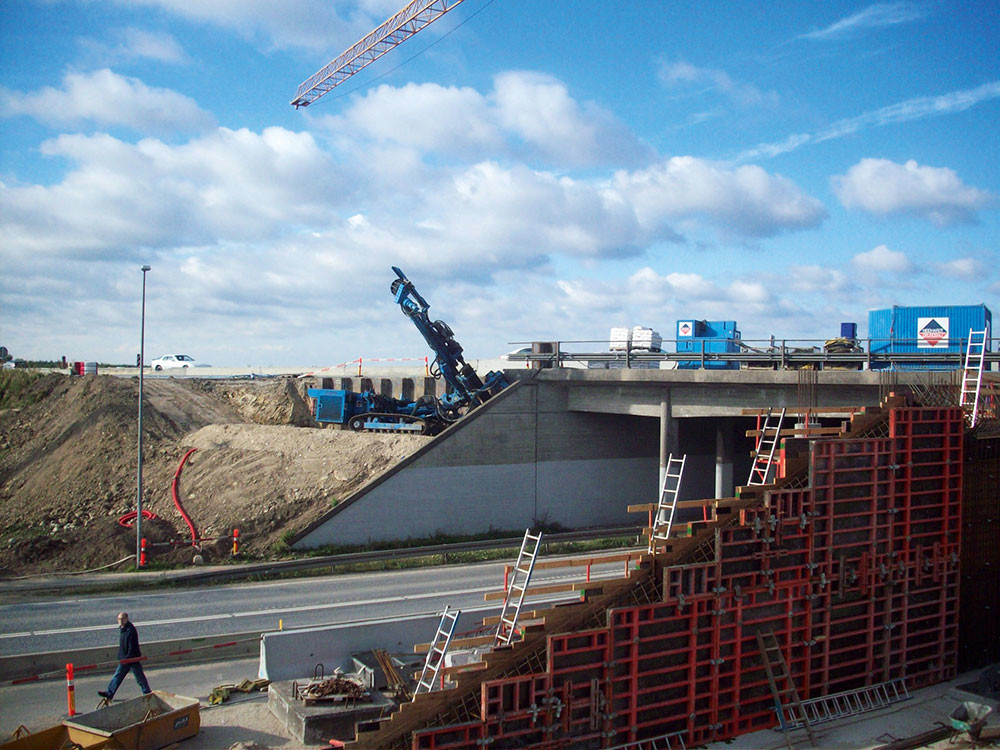Holbækmotorvejen Roskilde
In the course of widespread infrastructure projects the „Holbækmotorvejen“ are being enlarged on a several kilometer long stretch around Roskilde, Denmark. Consequently, numerous bridges had to be renovated, widened or entirely demolished and rebuilt. We had been enlisted as a subcontractor on one of the three sections under responsibility of the Danish construction heavyweight E. Pihl & Søn A.S. It was our task to secure two motorway bridges transversing the Ringstedvej as well as a nearby railway line with temporary grout anchors, as the counterforts had to be laid open for enhancement in some parts.
On the southwest side of the bridge crossing Ringstedvej we anchored a sheet pile wall with 10 temporary strand anchors with 3 strands each in order to stabilise the elevated roadway for the duration of the construction works (see Image 2). The water supply of our drill unit was established by means of a tank truck. Due to the relatively enclosed position of the last drill point near the counterfort, we moved this anchor in agreement with our client in a way such that a perpendicular joint to the intended waling could be established with ease.
A few weeks later, we were supposed to anchor the northeast and the southwest side of the neighboring motorway bridge across the railway line with 3 pcs. temporary strand anchors. Absorbing and transmitting the active earth and traffic loads acting upon the sheet pile walls into lower subsoil layers our grout anchors thereby stabilise the roadway and protect it from settling. Due to an even tighter working niche than on the previous mission, we chose a compact mini drill rig to execute this job (see Image 1).
However, as we experienced much less favourable ground conditions within the roadway than anticipated, our endeavour developed into a real challenge. The motorway surface had already settled by several inches when the steel sheet piles had been vibrated in place; a circumstance that we were able to attribute right away to the coarse gravel material in the grouting depth. But because we judged the upper ground layers only partially suitable for absorbing the intended service loads, we had no choice but drill into the gravel layer that was spiked with gaps and holes. From a drilling perspective, we had to expend some patience and sensitivity in order to succeed.
Moreover, it quickly turned out that we could neither produce a satisfying grout pressure during our secondary injections nor could we compel much of a backflow of our grout material toward the anchor hole. We encountered these problems with both an up to threefold increase in injection quantities per anchor and two additional anchors for extra support in case the load tests were to deliver poor results.
Fortunately, we were able to have two additional anchors prepared and delivered to the site overnight. As an option of last resort, we equipped the last anchor with an anchor bag serving as a filter to retain only dense grout material inside of it, thereby guaranteeing that the steel strands were completely enclosed by grout suspension until the hardening process took hold to form a proper grout body. Fortunately, the results of our acceptance tests according to DIN EN 1537 one week later turned out for the best proving that all our anchors could be subdued to the planned service loads, so any plans for taking extensive secondary measures could be abolished in the end.

